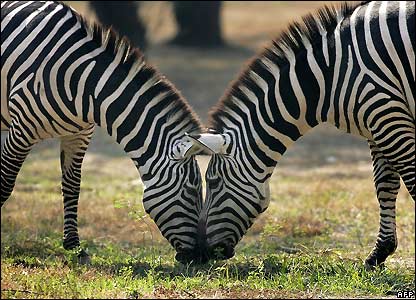tags: zebras, Equus quagga burchelli, photography, Image of the Day
Burchell's (plains) zebras, Equus quagga burchelli, create a mirror image in their enclosure at the Zoological Park in Delhi, India.
Image: BBCNews.
Burchell's zebra has distinctive stripes that run diagonally and lengthways on the rump and continue on to the belly. They often have chestnut or yellowish "shadow" stripes in the middle of the white stripes on their rumps. If you look closely at the two animals in the image, you'll notice that they are not marked identically -- in fact, each individual zebra has a unique stripe pattern, just as humans have unique fingerprints.
There are three living species of zebras: Grevy's zebra, Equus grevyi, the mountain zebras, Equus zebra (two subspecies), and the Plains Zebra (above), which is the most common zebra species and has approximately twelve subspecies, including the now extinct Quagga, Equus quagga quagga.


A 2004 paper by Groves and Bell argued that the Hartmann's Mountain Zebra should be considered a separate species from the Cape Mountain Zebra, in which case it would be Equus hartmannae. However, a Moodley and Harley paper in 2005 showed that there is no genetic evidence to regard the two populations of mountain zebras as anything more than different subspecies, while also arguing that the current separate populations are an artifact of historical human persecution.
Oh, and most recent thinking suggests that the Plains Zebra has at most 6 subspecies.
"Simultaneously all three went for the ball, and the coconut-like sound of their heads colliding secretly delighted the bird."
If only there was another skull in there...
Great photo!
I'm always amazed at how hard it can be to see such a funny striped animal in the bush. When in the open they look like they would be impossible to miss.